News 2018
Maritime shipping too has to become (even) more environmentally friendly. Therefore, since the beginning of 2018, the EU prescribes that the shipowners have to trace the emissions of their ships. This requirement of the so called MRV Regulation are now supplemented with new rules by the International Maritime Organisation IMO. We explain the differences between the two systems.
The Regulation (EU) 2015/757 on the monitoring of carbon dioxide emissions from maritime transport applies since 2018. This regulation is better known under its abbreviation MRV which stands for monitoring, reporting and verification. Now the IMO has added another system: the Data Collection System (in short: DCS). In this system the fuel consumption of maritime ships is established.
Both procedures resemble one another and shipowners can use some of the collected data for both systems. But there are also differences. For example, in Germany different authorities monitor the compliance of the requirements.
We have compiled the most important differences for you in the following table. Below the table, you will find more detailed information about the two procedures.
| Procedure: | EU MRV Regulation | IMO DCS (Data Collection System) |
|---|---|---|
| Monitoring of: | carbon dioxide emissions | IMO DCS (Data Collection System) |
| Application: | from 5000 GT commercial voyages to or from a port or between ports in the European Community |
from 5000 GT international voyages (large fishing vessels and offshore jack-up vessels are also included) |
| Implementation with: | verification of a monitoring concept by an accredited verifier | with the SEEMP (Ship Energy Efficiency Management Plan), incl. part II, verified by a recognised classification society → survey report or Confirmation of Compliance to Ship Safety Division for approval (until 31. December 2018) |
| Start of data collection: | since 1. January 2018 | from 1. January 2019 |
| Data submission: | Emission report to Deutsche Emissionshandelsstelle (at the Federal Ministry for the Environment) until 30. April the following year | to Ship Safety Division until 1. April the following year; entry of the data into the IMO database by Ship Safety Division or commissioned class |
| First submission until: | 30. April 2019 | 1. April 2020 |
| Further information: | ISM Circular 01/2018 | ISM Circular 05/2018 |

EU MRV Regulation (carbon dioxide emissions)
The maritime transport regulation EU MRV ((EU) 2015/757) is applicable for ships of 5000 GT and above which conduct commercial voyages to or from a port or between ports in the European Community. The EU Regulation stipulates monitoring of carbon dioxide emissions from maritime traffic with a monitoring concept verified by an accredited verifier.
Annually, an emission report for the ship, based on the collected data and positively assessed by an accredited verifier with a Document of Compliance, is reported to the Deutsche Emissionshandelsstelle until 30. April of the following year. This Emissionshandelsstelle is part of the Federal Ministry for the Environment. The Document of Compliance is to be carried on board the ship.
Emissions have to be collected since 1. January 2018. The first Emission report is due on 30. April 2019.
Further information is given in our ISM Circular 01/2018.
IMO Data Collection System (fuel consumption)
The IMO has approved a system to record data about fuel oil consumption of ships (DCS) for ships on international voyages with 5000 GT an above and has included this in the MARPOL Convention Annex VI. For the implementation, the SEEMP (Ship Energy Efficiency Management Plan) has been extended with a part II: the ship fuel oil consumption data collection plan.
For sea-going ships under German flag, the shipowner submits the SEEMP with the supplemented part II to a recognised classification society for verification. The class submits their Survey Report or the Confirmation of Compliance - Ship Fuel Oil Consumption Data Collection Plan to the Ship Safety Division of the BG Verkehr for approval which issues the relevant confirmation for the ship. The approval by the Ship Safety Division has to occur until 31. December 2018.
The shipping company submits the collected data to the ship safety Division until 1. April of the following year. The first submission is due on 1. April 2020.
The collected data on the fuel oil consumption are entered annually into the IMO database of fuel oil consumption of ships by the Ship Safety Division or the commissioned class. For each ship under German flag, the Ship Safety Division issues a Statement of Compliance - Fuel Oil Consumption Reporting to confirm the proper submission of the annual consumption report to the IMO.
Further information and details about the required data and the various measuring methods are given in the ISM Circular 05/2018.
The German Bundestag paved the way for the German ratification of the convention with the unanimous adoption of the draft law on the Ship Recycling Convention of the IMO and takes a stand for safe and environmentally sound recycling of ships.
Since the 1970s, ship breaking has shifted from Europe to Asia. Shipyards in Europe had become too small for large sea-going vessels and an expensive work force as well as strict environmental provisions gradually drove up the costs.
In Asia ships are broken down on beaches instead of in shipyards. The work and wage conditions as well as the pollution by these ship breaking places has long been criticised internationally. With the Hong Kong Convention 2009, the IMO has created requirements and regulations for safe and environmentally sound recycling of ships.
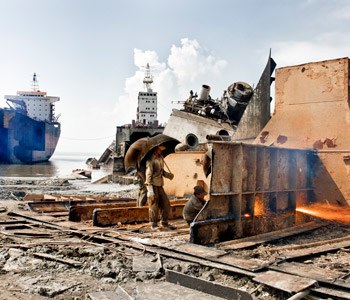
The Convention does not apply to ships under a gross tonnage of 500 and ships that have solely been deployed on national voyages. However, these ships should also be recycled in a sustainable way and with consideration for the environment.
Both the EU Ship Recycling Regulation (EU SRR) and the German law for the ratification of the Convention are supposed to raise awareness of the topic with other flag states so that they might join the Convention. The Convention will only come into force once at least 15 parties with a total of 40% of the world gross tonnage and at least 3% of the annual global total tonnage of recycled ships have ratified the Convention.
The Federal Ministry of Transport and Digital Infrastructure has entrusted the Ship Safety Division of the BG Verkehr and the Federal Maritime and Hydrographic Agency (BSH) with the enforcement of the Convention in Germany and on ships flying the German flag.
In the future, the Ship Safety Division will issue a document that certifies that an Inventory of Hazardous Materials exists and complies with IMO requirements. The Inventory lists all hazardous materials contained in the ship's structure or equipment, their location and approximate quantities. The inventory must be kept up-to-date throughout the whole operational life of the ship.
Prior to the voyage to the ship recycling facility, the Ship Safety Division conducts a final survey and declares the ship clear for recycling. During port state control inspections, the ship will also be checked for compliance with the Convention.
The BSH will be the competent authority for the authorisation of national ship recycling facilities. Prior to the recycling of a ship, the agency approves the Ship Recycling Plan of the recycling facility.
The new guidelines of the International Transport Workers’ Federation (ITF) and the International Chamber of Shipping (ICS) aims to contribute to better working and living conditions of seafarers. The authors explain the different social aspects for a uniform implementation of the Maritime Labour Convention.
With the Maritime Labour Convention (MLC), the International Labour Organisation ILO laid down binding and worldwide requirements which provide seafarers with the right to appropriate work and life on board sea-going vessels. Now the new Guidelines for implementing the Welfare aspects of the Maritime Labour Convention 2006 follow with practical guidance.
In the guidelines it is described which social support contributes to the welfare of seafarers. The usage of the internet on board as well as in the ports plays an important role in the day-to-day life of seafarers. The protection of underage seafarers and reliable payment of wages - even in the event of illness – are further requirements with direct impact for the seafarers.
For seafarers their ships are not only workplace but for long stretches of time the place where they spent their time off. Seafarers from all around the world work and live together in limited space far from their friends and family. The guidelines explain that this difficult situation can be eased by appropriate accommodation (e.g. good furnishings, ventilation, heating, adequate separation of operational and sleeping areas), compliance with health and safety standards (medical equipment, sanitary facilities, etc.) and regard for personal needs (this also includes spaces for religious activities and recreational facilities and equipment). Other aspects that need to be taken into account are a healthy and balanced diet as well as occupational health and safety.
As seafarers usually spend only a rather short time with their ship in a port, it is crucial that the orientation at these often new and alien places is facilitated. The accessibility of urban facilities such as banks, doctors, advisory or counselling services, shopping places or recreational facilities as well as welfare facilities (e.g. seamen's missions) have proven to be important. Therefore, the member states of the ILO should support financing and organisation of these onshore social facilities.
Germany bindingly joined the Maritime Labour Convention (MLC) in 2013. With the German Maritime Labour Act, the legislator brought into force the provisions of the Convention in German law. For all parties involved in implementing these provisions, the German Flag State Administration also published comprehensive and recently revised Guidelines on the implementation of the Maritime Labour Convention on board of German flagged ships. On the webpages of the section "Crew", there is further information given about this topic.
New requirements for medical equipment on board of merchant ships flying the German flag have come into force.
The new "State of medical knowledge" includes, besides an equipment list, practical information on the storage of drugs and medical products on board. Shipowners only have to implement the changes of the medical equipment by the next annual inspection.
More information on this topic can be found in our section on "Maritime Medicine". The changes in comparison to the previous state of medical knowledge are given in an information leaflet (in German only).
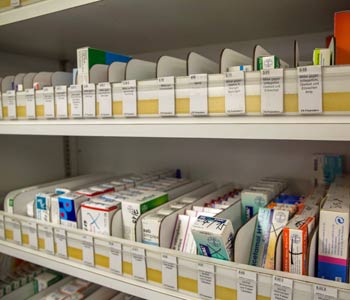
The United States Coast Guard (USCG) has issued a safety notice for immersion suits. With several suits the glue used to attach the main zipper to the body of the suit had failed. The suits concerned are of the type Rongsheng RSF-1. Please find further details in the document referred to above.
If you have any immersion suits of this type on board, check their proper condition. If you detect any defects, please inform the market surveillance (Marktüberwachung) of the BSH.
In addition, this notice has been published in the Notices to Mariners - Nachrichten für Seefahrer (issue 19/2018).
Find an overview of all safety notices and product recalls here.
The International Maritime Organization IMO celebrates its 70th anniversary at the 27th World Maritime Day on 27 September 2018. The Federal authorities in the port cities and towns hoist their flags to mark the occasion.
This year's theme of the World Maritime Day is "IMO 70: Our Heritage – Better Shipping for a Better Future". The Internationale Maritime Organization celebrates its 70th anniversary since the adoption of the IMO Convention.
The IMO is a specialized agency of the United Nations which shapes international maritime shipping like no other organization. Among its most important instruments are conventions such as SOLAS, MARPOL, MLC and STCW as well as various codes (IMSBC, Polar Code, Code on Intact Stability, Code for Fire Safety Systems, Life-Saving Appliance Code and many more).
The IMO's, by now, 173 member states have committed themselves to comply with more than 50 international instruments and see to safe, secure, sustainable, environmentally sound and efficient maritime shipping.
Over 80% of global trade takes place at sea. The IMO creates a level playing field and keeps an eye out for its impacts. It defines international standards for ship design and construction, training of seafarers, safe navigation and prevention of pollution by ships.
From 25 May 2018, the new European General Data Protection Regulation applies and it contains many new data protection provisions for the citizens of the European Union.
The authorities of the German Flag State Administration have prepared data protection information for you. It informs you about the different areas the authorities use your personal data.
Data protection information of Ship Safety Division / BG Verkehr
Data protection statement of the BSH
Find out more about our data protection policies in our statement on protection of data.
The Seafarer's Compendium of the BG Verkehr has become a popular standard work for any question regarding safety on board of sea-going vessels. In addition to the hardcopy version, an award-winning digital version for mobile devices is now available.
By now on almost every German sea-going ship, a copy of the compendium "Occupational safety and health protection on board of merchant and fishing vessels" (Handbuch See – Arbeitssicherheit und Gesundheitsschutz in der Seeschifffahrt und Fischerei) can be found. 69 modules illustrate with few words and "talking" pictures to what seafarers have to pay attention in order to neither put themselves or anyone else in danger. During an instruction about certain topics, the corresponding modules can be used as a basis for remarks. This book of reference is now also available as digital version for mobile devices.
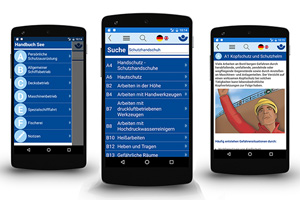
Winner of the "eLearning Award 2018"
The implementation of the well-established compendium electronically is fashioned to serve the particular conditions at of maritime shipping. Independent of time and place and an internet connection, the essential information is available to the user both on- and offline. The user can readily change between German and English. A keyword search makes it easy to quickly find specific contents. As an additional innovation, it is now possible to document and save data like photos and notes, for example about injuries to persons or property damages and near accidents.
These many useful functionalities also managed to impress on the education fair didacta. In the category knowledge management, The BG Verkehr was awarded the "eLearning Award 2018" for their app.
The app is now available for free download in the app stores for Android and iOS operating systems.
Current Information
The Federal Maritime and Hydrographic Agency (Bundesamt für Seeschifffahrt und Hydrographie, BSH) now issues (since 1st November 2017) all of the liability certificates electronically and also sends them electronically. The electronic liability certificates do not have a signature or a stamp of the BSH anymore but a QR Code and a Tracking Identification Number (TID).
Below you can find model electronic liability certificates:
- Civil Liability Certificate (oil cargo)
- Civil Liability Certificate (bunker oil)
- Wreck Removal Liability Certificate
- Passenger Liability Certificates
Application
As of now, you can apply for the issuance of a liability certificate for the next insurance year (2018/2019) at the BSH. If you are currently missing documents (e.g. Blue Cards), you can submit those later.
You can find the application forms for the liability certificates in our section "Applications and Documents" . You can now apply for all liability certificates by simple e-mail. You do not have to send in the original documents anymore.
The BSH only requires one application per ship for the issuance of liability certificates for:
- Oil cargo (in accordance with the 1992 Liability Convention)
- Bunker oil (in accordance with 2001 Bunkers Convention)
- Wreck removal (in accordance with the Wreck Removal Convention)
For the passenger liability certificate (in accordance with Regulation (EC) No. 392/2009), please use the separate application.
Please note:
- Please name a central e-mail address to which the BSH can send documents. They will be sent from the no-reply-address liability@bsh.de.
- As usual, you have to attach the Blue Card and the ITC 69 or a valid PSSC to the application. If the registered owner or the carrier is represented by an authorised person, a written or electronic "Authorisation to make the application" has to be attached.
- If a person authorised to receive communication needs to be named (if the ship does not fly the German flag and/or the registered owner or carrier, respectively, does not have the permanent residence or the place of business in Germany), an "Authorisation to receive communication" has to be presented; an electronic copy suffices.
- Generally, the notification of fees is sent to the registered owner or the carrier, respectively. It is also possible, however, to name a different addressee for the fee notification.
- If you submit the application or the attachments neither in German or English, you have to attach a translation by a translator approved by the appropriate authority.
Important
Please send the application documents (PDF files) via e-mail to the following designated e-mail addresses:
- nwrc@bsh.de for liability certificates (oil liability and wreck removal liability)
- plc@bsh.de for Passenger Liability Certificates
Please do not use personal BSH-email-addresses, because the processing is only guaranteed via the designated e-mail-addresses.
Issuance of liability certificates
As of now, you will receive the liability certificates with the accompanying documents exclusively via e-mail from the no-reply-email-address laibility@bsh.de. The following documents will be attached to the E-Mail:
- the cover letter,
- the liability certificate,
- the notification of fees,
- the "information letter": an explanatory letter which outlines how the authenticity and the validity of the electronic certificate can be verified.
Verification of electronic liability certificates
The verification of the electronic liability certificates occurs during port state inspections or other inspections in the section "E-Certificates" of this website. The QR Code directs you to the website; after entering the Tracking Identification Number (TID) which is on the liability certificate, the document will open.
Any liability certificates issued in paper form will of course remain valid.
With questions please refer to:
- other questions: Ms Cordes, phone: +49 40-3190 7437, or
- the designated e-mail-address nwrc@bsh.de
- only in case of an emergency: Maritime Hotline, phone: +49 40-3190 7777.
Due to two fires on board ships during the transport of fertilizer, the IMO has published a Circular regarding conditions for the carriage of ammonium nitrate based fertilizer.
Ammonium nitrate based fertilizers are classified as Group C (non-hazardous) in the IMSBC Code, but the two casualties have proven that some fertilizers decompose under unfavourable conditions during transport and may consequently release highly toxic gases.
The Circular of the Subcommittee "Carriage of Cargoes and Containers" (CCC) of the International Maritime Organization IMO contains concrete advice on how to transport ammonium nitrate based fertilizer and what needs to be done in case of the development of decomposition or a fire.
You can find further Information on this topic under "Bulk Cargoes - IMSBC Code"
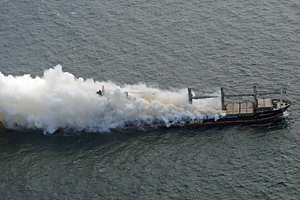
Which medical equipment is required depends on the trading area, among other things. Our two new maps offer an overview of these trading areas.
The current "State of Medical Knowledge" informs about the medical equipment required on board. The scope of the equipment depends on the amount of people on board, the trading area and whether it is a fishing vessel.
The Federal Maritime and Hydrographic Agency BSH designed in cooperation with the Maritime Medical Service of BG Verkehr two maps of the trading areas to give you a better overview. One map offers an overview of the trading areas for merchant ships (without fishing vessels) and the other of the trading areas of fishing vessels.
The trading areas of merchant ships are divided into
- port area,
- domestic and near-coastal voyage,
- European voyage, and
- international voyage.
For fishing vessels, the trading areas for different sets of medical equipment are
- coastal fishing,
- high sea fishing, and
- deep sea fishing.
Further information on medical equipment on ships can be found in our rubric "Maritime Medicine".
Overview of information about the implementation and practical examples
You can find interesting information about regulations regarding ballast water exchange and ballast water management in our information leaflet. In the leaflet, we explain the D-1 and D-2 standard and which one applies in which circumstances.
In addition, we explain the special regulations for Baltic Sea and North Sea and show with the aid of practical examples which rules apply in which situations. A new and visually improved map illustrates the ballast water exchange area in the North Sea.
This and further information can also be found in our FAQs on the topic and under the heading "Environmental protection / Ballast water".
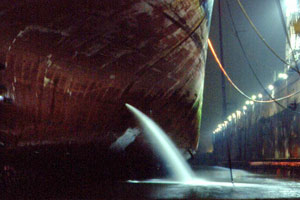
Malaria is a dangerous infectious disease which can be caught during voyages in risk areas. If it gets detected in time, it is curable. Untreated, some forms of Malaria can cause severe organ damages and even lead to death.
The Maritime Medical Service (Seeärztlicher Dienst) of the BG Verkehr updated all important information about the disease and its prevention in the new Leaflet on Malaria. It also details how to get the case of Malaria recognized as occupational disease.
In comparison to the previous version, the Malaria leaflet of the BG Verkehr contains three alterations:
- The map of areas with a high risk of Malaria transmission has been updated,
- The information that the drug Malarone can be taken over a longer period of time,
- The detailed description with photos of how to prepare a blood sample for the recognition as an occupational disease later on.
For a hardcopy of the brochure of the Leaflet on Malaria please refer to Mr. Meixner, phone +49 40 36 137-236 or e-mail: klaus.meixner@bg-verkehr.de.
Please note that the old leaflet has to be replaced at the latest for the next inspection of the medicine cabinet, in accordance with section 109 paragraph 3 of the German Maritime Labour Act).
Further information on medical equipment on board of ships can be found in our rubric "Maritime Medicine".
Contribution rates for social security for 2018
| Health insurance | |
|---|---|
|
General contribution rate (exkl. individual additional contribution) |
14,60 % |
|
share employee |
7,30 % |
|
plus additional contribution by employee (varies depending on health insurance) |
|
|
share employer |
7,30 % |
| Long-term care insurance | |
|
contribution rate overall |
2,55 % |
|
share employee |
1,275 % |
|
share employer |
1,275 % |
|
childless overall |
2,80 % |
|
share employee |
1,525 % |
|
share employer |
1,275 % |
| Pension insurance | |
|
General pension insurance |
18,60 % |
|
share employee |
9,3 % |
|
share employer |
9,3 % |
| Seafarer's special fund | |
|
contribution rate |
4,00 % |
|
share employee |
2,00 % |
|
share employer |
2,00 % |
| Unemloyment insurance | |
|
contribution rate |
3,00 % |
|
share employee |
1,50 % |
|
share employer |
1,50 % |
| Maritime accident insurance | |
|
contribution rate seafarers |
4,9 % |
|
Fraction employees on shore in maritime businesses |
1/8* |
| Other contribution rates | |
|
contribution 1 = illness, courses of treatment (reimbursement rate 80%) |
0,90 % |
|
contribution 2 = maternity leave (reimbursement rate 100%) |
0,24 % |
|
contribution to the insolvency fund |
0,06 % |
*earnings subject to contributions x 1/8 (fraction) x 4,9 % (contribution rate) = contribution
Status 20.12.2017; errors and omissions excepted.
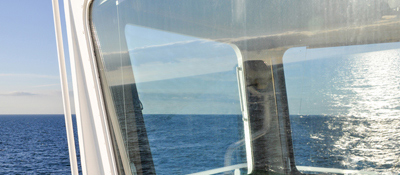
Operands concerning social security for 2018
| Reference value - § 18 SGB IV – in EUR | Contribution assessment ceiling in EUR | ||
|---|---|---|---|
| Health- and Long-term care insurance | |||
|
Entire Federal Republic |
3.045,00 / month 36.540,00 / year |
4.425,00 / month 53.100,00 / year |
|
| Pension- and unemployment insurance | |||
|
Old German States (incl. Berlin/West) |
3.045,00 / month 36.540,00 / year |
6.500,00 / month 78.000,00 / year |
|
|
Newly-formed German States (incl. Berlin/East) |
2.695,00 / month 32.340,00 / year |
5.800,00 / month 69.600,00 / year |
|
| Seafarers' special fund | |||
|
Old German States (incl. Berlin/West) |
- |
6.500,00 / month 78.000,00 / year |
|
|
Newly-formed German States (incl. Berlin/East) |
- |
5.800,00 / month 69.600,00 / year |
|
|
|
|||
| Accident insurance: maximum annual income | |||
|
Maximum annual income (per employee) |
72.000,00 EUR |
||
| Annual earning limit | |||
|
General limit |
59.400,00 EUR |
||
| On-board catering– catering rates | |||
|
Full catering monthly |
246,00 EUR |
||
|
Lunch and dinner each monthly |
96,00 EUR |
||
|
Breakfast monthly |
51,00 EUR |
||
| Current exchange rate for non-German seafarers on GIS ships (§ 17a SGB IV) | |||
|
Reference rate ECB October 2017 |
Valid 01.01.-31.03.2018 |
1 USD = 0,8506 € |
1 € = 1,1756 USD |
|
Reference rate ECB July 2017 |
Valid 01.10.-31.12.2017 |
1 USD = 0,8687 € |
1 € = 1,1511 USD |
|
Reference rate ECB April 2017 |
Valid 01.07.-30.09.2017 |
1 USD = 0,9326 € |
1 € = 1,0723 USD |
Status 20.12.2017; errors and omissions excepted.


